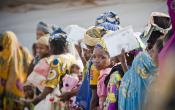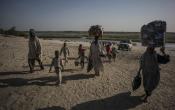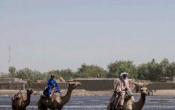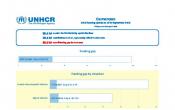Cameroon
Operation: Cameroon
Location
{"longitude":12,"latitude":5,"zoom_level":0}
Latest update of camps and office locations 13 Jan 2016. By clicking on the icons on the map, additional information is displayed.
Key Figures
| 2015 end-year results | |
| 49% | of CAR refugee children enrolled in primary school |
| 35,000 | CAR refugee households received core relief items |
| 3,000 | IDPs received shelter support |
| 90% | of primary school-aged Nigerian refugee children enrolled |
| 2016 planning figures | |
| 40,000 | registered refugee children targeted to be enrolled in primary education |
| 66,000 | people of concern targeted to receive long-term/permanent shelter |
Latest Updates and Related Links
People of Concern
66%
Increase in
2015
2015
| 2015 | 459,650 |
| 2014 | 276,265 |
| 2013 | 123,090 |

[["Refugees",327121],["Refugee-like situation",15852],["Asylum-seekers",5373],["IDPs",92657],["Returned IDPs",18636],["Others of concern",11]]
Loading ...
Budgets and Expenditure for Cameroon
< Back
2015
{"categories":[2012,2013,2014,2015,2016],"budget":[20.6565492,23.58358842,81.27658602,114.697643602,98.62460251],"expenditure":[10.76662458,12.96600018,44.17872352,50.71501571,null]}
{"categories":[2012,2013,2014,2015,2016],"p1":[19.83024575,22.80065742,80.48365484,107.653576378,89.4764597],"p2":[0.82630345,0.782931,0.79293118,0.843987224,1.885381],"p3":[null,null,null,null,null],"p4":[null,null,null,6.20008,7.26276181]}
{"categories":[2012,2013,2014,2015,2016],"p1":[10.54988338,12.84369964,44.04089519,45.95148629,null],"p2":[0.2167412,0.12230054,0.13782833,0.207295,null],"p3":[null,null,null,null,null],"p4":[null,null,null,4.55623442,null]}
Loading ...
CHOOSE A YEAR
- 2014
- 2015
- 2016
Working environment
- By the end of 2015, Cameroon was hosting the largest number of refugees from the Central African Republic (CAR), with more than 252,000 refugees residing in the East, Adamawa and North departments, and about 68,000 Nigerian refugees living in the Far North department bordering Nigeria. The cross-border incursions of foreign armed groups also led to the internal displacement of 92,000 people in the Far North.
- Operations in the Far North aiming to assist and protect Nigerian refugees and internally displaced persons (IDPs) faced considerable challenges owing to a highly volatile security environment in the three border departments and a rising number of cross-border raids. In response, security measures were tightened, including through the reinforcement of military activities.
- UNHCR experienced difficulties gaining access to CAR refugees living in over 300 villages located in hard-to-reach areas, particularly during the rainy season. In addition, owing to the pastoral lifestyle of the refugees, conventional support, tracking and monitoring systems fell short, and UNHCR and its partners had to adjust their protection and solutions strategy.
Population trends
- In 2015, UNHCR and Cameroonian authorities registered the arrival of 21,000 new CAR refugees, which is considerably less than in 2014 (131,000 refugees). By year end, there were some 253,000 CAR refugees in Cameroon, 179,000 of which voluntarily settled with host communities. The remaining 74,000 settled in the seven sites which UNHCR and partners built in 2014.
- UNHCR and Cameroonian authorities also registered 29,000 new Nigerian refugees in Minawao camp in the Far North. By year end, Cameroon was hosting some 52,000 Nigerian refugees in Minawao camp, with an additional 15,852 settling in neighbouring villages along the border.
- The situation in Nigeria also led to the internal displacement of nearly 93,000 Cameroonians.
Achievements and impact
- Biometric verification was conducted in Yaoundé in December 2015, resulting in improved data quality, harmonized refugee documentation and new refugee identity cards for adults and unaccompanied minors.
- The operation for CAR refugees extended to out-of-camp settings. UNHCR, in collaboration with the Plan National de Développement Participatif (PNDP), began preparing a local development plan for refugee-hosting villages. Livelihood interventions were extended to villages, benefiting 30 per cent of host communities.
- UNHCR supported efforts which ultimately led to the participation of CAR refugees in the CAR constitutional referendum and presidential elections.
- After conducting a survey on the nutritional status and health of populations of concern, which revealed that refugees in some sites as well as out-of-camp areas have poor health and nutrition, UNHCR carried out targeted interventions in 2015 and helped to improve the situation. The mortality rate among children under the age of 5 reached acceptable standards.
Unmet needs
- The majority of gaps, especially those relating to limited access to health, water and education services, stem from the poor level of infrastructure in the villages that host Central African refugees. Health and nutrition centres are under-equipped and under-staffed and cannot absorb the needs of the refugees and the host community, which hampers the former’s integration. Secondly, access to water remains below standard in host villages and in the sites.
- Key mechanisms for child protection, including community-based child structures, identification of children at risk and BID procedures have not been established in many refugee hosting villages.
- The issues of access to energy and protection of the environment to mitigate the impact of the growing Minawao camp has never been addressed because of a lack of resources. This puts Nigerian refugees, especially girls and women, at risk when collecting firewood, and threatens peaceful coexistence between refugees and host communities, given the competition over control and access to natural resources.
- Because of limited access due to the insecure environment, the majority of IDPs did not have adequate access to shelter assistance and NFIs.
Working environment
Cameroon maintains an open-border policy for asylum-seekers and is signatory to all major legal instruments on refugees, including the 1951 Refugee Convention and the 1969 OAU Refugee Convention. Moreover, Cameroon adopted a law defining the legal framework for refugee protection in July 2005, which went into force in November 2011.Continued regional instability means Cameroon has been receiving refugees and asylum-seekers from neighbouring countries, mainly from the Central African Republic (CAR) and Nigeria. As of August 2014, Cameroon was hosting more than 240,000 people of concern to UNHCR.
Cameroon hosts the largest number of Central African refugees. Most are spread over at least 314 sites and villages across the East and Adamaoua regions. The extensive CAR border presents a challenge for humanitarian actors on the ground, with more than 30 entry points and an operational area of 50,000 square kilometres. This is further aggravated by poor road conditions, making access difficult.
Due to the crisis in Nigeria, Cameroon has witnessed an influx of Nigerian refugees since May 2013. The volatile security situation at the border, including continued incursions by armed groups from Nigeria into Cameroon, poses serious risk of targeted violence, robbery or kidnapping.
The Government provides protection and asylum for people of concern and has allocated land for seven refugee sites in the East and Adamaoua regions, as well as Minawao refugee camp in the Far North region. It also provides armed escorts for refugees and humanitarian actors in operational areas and facilitates access to local schools and health centres for refugees, with UNHCR support.
Needs and strategies
In 2015, UNHCR will provide protection and assistance to the different refugee groups.The CAR refugees who arrived between 2006 and 2010 and are residing with host communities will be targeted using a local integration strategy that aims to restart livelihoods and build community capacity.
UNHCR will focus on the most immediate priorities of CAR refugees who have arrived since 2013 and reside in the refugee sites or host communities in the East and Adamaoua regions. Priorities include: ensuring physical protection from armed conflict; providing access to basic assistance; improving the health condition of refugee populations; ensuring access to education; and increasing or maintaining water supplies, particularly for refugees residing in host communities. Attention will be given to strengthening the prevention of, and response to, sexual and gender-based violence (SGBV) in refugee sites and host communities. UNHCR and partners will accelerate efforts to develop income generating and livelihood activities for refugees, to facilitate their integration in host communities. To reduce the risk of conflict stemming from control of natural resources, and to reinforce social cohesion, solutions to mitigate the impact of a mass influx of people will be developed and implemented. As refugees are hosted in some of the country’s poorest areas, where basic infrastructure such as schools, health-care centres and water points are lacking, significant investment will be required.
UNHCR will also respond to the needs of the Nigerian refugees. New arrivals will continue to be hosted in Minawao refugee camp, where existing infrastructure will be extended. If required, additional camp sites will be identified and developed, in collaboration with local authorities. Local integration of Nigerian refugees is not envisaged for 2015.
In an effort to reduce statelessness, UNHCR will continue to advocate issuing birth certificates, to support civil registration centres and to sensitize parents regarding the importance of birth registration.





